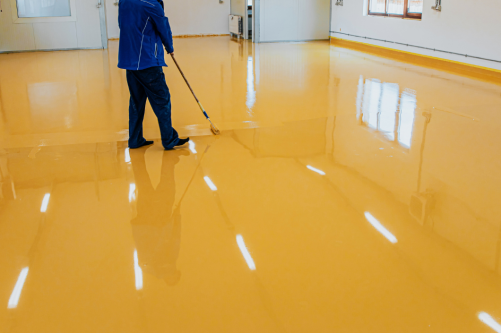12 Expert Tips for a Perfect Epoxy Flooring Finish

When it comes to industrial flooring, durability, hygiene, and long-term performance are non-negotiable. That’s why epoxy flooring paint is trusted across manufacturing plants, warehouses, workshops, and logistics hubs. With its superior resistance to wear, chemicals, and moisture, epoxy paint delivers a hard-wearing, professional finish that lasts for years.
Below are 12 deeply explained tips to help you apply epoxy flooring paints like a pro and ensure it meets industrial and export-grade standards.
1. Choose the Right Epoxy Paint
The first and most important decision is selecting a type of epoxy paint suited for your operational environment. Not all epoxy coatings are designed for the same job.
- For manufacturing plants: Go for 100% solids epoxy paint that can handle forklift traffic, impact, and constant vibration.
- For wet areas or food units: Choose waterproof epoxy floor paint that resists mold, bacterial growth, and slip hazards.
- For export logistics hubs or open areas: UV-resistant epoxy paints are vital, especially in regions with strong sunlight.
- For light-duty interiors: Water-based epoxy paints offer ease of use and low odor but are best for retail or office spaces.
2. Surface Preparation for Strong Epoxy Floor Coating
The final outcome of your epoxy floor coating depends heavily on the condition of the surface underneath. Even the best epoxy can fail if the base isn’t properly prepared.
1️⃣ Remove dust, grease, oil, paint, or any contaminants
2️⃣ Repair cracks, holes, or dents in the concrete
3️⃣ Use a moisture meter to check for dampness
⚠️ Skipping this step often leads to poor adhesion, bubbling, or peeling within months of application.
3. Improve Adhesion with Primer
A primer acts as the foundation that locks the epoxy to the floor. It penetrates porous concrete, blocks air bubbles, and improves product coverage.
Why it matters:
-
On highly porous or absorbent floors, epoxy can soak in and lead to patchy curing.
-
A good primer acts as a moisture barrier, especially important in basements, food factories, and humid zones.
-
It reduces the amount of topcoat needed and helps prevent fish-eyes or pinholes in the finish.
✔️ Always select a primer that’s compatible with your topcoat. Epoxy systems are designed to work together, don’t mix brands unless approved by the supplier.
4. Maintain Proper Temperature and Humidity
Epoxy flooring paint is a chemically reactive product. Its behavior changes depending on temperature and humidity.
Ideal conditions:
- Temperature: 20°C to 25°C (68°F to 77°F)
- Relative humidity: Below 85%
Why it matters:
✔️ High humidity can trap moisture inside the floor, causing whitening, blistering, or even delamination.
✔️ Cold temperatures delay curing, which increases dust attraction and surface defects.
✔️ Use a hygrometer and infrared thermometer to verify conditions before and during application.
5. Mix Epoxy Paint Accurately
Epoxy paint usually comes as a two-component system: Part A (resin) and Part B (hardener). The chemical bond that gives epoxy its strength only forms if mixed correctly.
Mixing checklist:
- Use a clean bucket and a slow-speed drill (200–300 RPM) with a mixing paddle.
- Mix Part A and Part B thoroughly for 2–3 minutes, scraping the sides and bottom.
- Do not whip or stir too fast—it introduces air bubbles, which can leave craters.
- Mix only what you can use within its pot life (typically 30–45 minutes at 25°C).
6. Choose the Right Application Tools
Using high-quality tools ensures the epoxy spreads evenly and doesn’t get damaged during application.
Recommended tools:
- Rollers with solvent-resistant covers
- Notched squeegees to spread the paint smoothly
- Spiked shoes so you can walk on the floor while applying without leaving marks
7. Apply Thin, Even Layers for a Stronger Finish
Epoxy coatings should always be applied in multiple thin coats rather than a single thick one. This allows better control over thickness and reduces curing defects.
General approach:
1️⃣ First coat: Primer or base coat to bond with the surface
2️⃣ Second coat: Mid coat for color and thickness
3️⃣ Third coat: Optional topcoat or anti-slip layer
Each coat must fully cure before applying the next. Check with the manufacturer for recoat windows (usually 6–24 hours).
🔹Thick application can lead to bubbling, yellowing, and improper curing—especially in warm climates.
8. Follow Pot Life and Curing Time Guidelines
Once epoxy is mixed, the clock starts ticking. You have a limited window to apply it before it thickens or becomes unworkable.
Key timings to track:
- Pot life: 30–60 minutes depending on the product and temperature
- Initial cure: 12–24 hours (light foot traffic allowed)
- Full cure: 5–7 days (suitable for forklifts, heavy equipment, and cleaning)
9. Add Anti-Slip Additives
In areas where floors can get slippery due to oil, water, or other fluids, anti-slip protection is critical.
How to add slip resistance:
- Mix silica sand or polymer beads into the wet epoxy
- Or broadcast them on the surface before applying the topcoat
This is especially useful in manufacturing plants, kitchens, or chemical industries where worker safety is a priority.
10. Apply a Protective Topcoat
A topcoat doesn’t just enhance the appearance — it also protects the epoxy from UV rays, scratches, and chemical spills.
Topcoat options:
- Glossy: Reflective and elegant
- Matte: Subtle and non-reflective
- Semi-gloss: A mix of both
Choose based on the lighting, usage, and function of the floor. Don’t skip this step if the area gets a lot of wear and tear.
11. Inspect the Surface and Fix Minor Imperfections
After curing, inspect the floor under strong lighting from different angles. Look for:
- Pinholes and air bubbles
- Foreign particles like hair, dust, or insects
- Inconsistent texture or missed areas
Address minor flaws with spot touch-ups while the surface is still receptive. Once fully cured, repairs may require mechanical abrasion and re-coating.
12. Maintain the Epoxy Floor with Regular Cleaning and Care
 Even the most robust epoxy floor paint will wear over time without proper maintenance. Set up a cleaning schedule to keep the floor looking and performing well.
Even the most robust epoxy floor paint will wear over time without proper maintenance. Set up a cleaning schedule to keep the floor looking and performing well.
Maintenance routine:
Monthly: Wet mop with non-acidic, non-abrasive cleaners
Every 1–3 years: Apply a maintenance topcoat in high-wear areas
Which Epoxy Floor Paint Should You Choose?
| Epoxy Paint Type | Where It’s Used | Key Benefit |
|---|---|---|
| Solvent-Based Epoxy | Garages, warehouses | Tough and glossy |
| Water-Based Epoxy | Shops, hospitals, indoor commercial areas | Easy to apply, low smell |
| 100% Solids Epoxy | Heavy-duty manufacturing floors | Thick, durable, high chemical resistance |
| Waterproof Epoxy Floor Paint | Wet areas, kitchens, basements | Protects against moisture and slips |
| UV-Resistant Epoxy Coating | Outdoor surfaces, driveways | Long-lasting under sun exposure |
Trusted Epoxy Flooring Paint Partner – Prime Roads
At Prime Roads, we specialize in epoxy floor coatings and road marking paints designed for Indian and international clients. From waterproof epoxy floor paint to epoxy paint for heavy-duty manufacturing plants, we provide products that meet both technical and commercial needs.
Why choose Prime Roads?
✅ High-quality formulations
✅ Consistent batch quality
✅ Export-ready packaging
Frequently Asked Questions
1. What makes epoxy paint ideal for industrial floors?
Epoxy paint provides a tough, chemically resistant surface that withstands high traffic, machinery, and chemical exposure, which is perfect for manufacturing and warehousing facilities.
2. Is waterproof epoxy floor paint necessary for all industries?
Waterproof epoxy is essential for environments prone to spills or moisture, such as manufacturing plants, food processing units, and laboratories.
3. How long does a professionally applied epoxy floor last?
With proper surface preparation and maintenance, epoxy flooring can last between 10–15 years, even in demanding industrial settings.
4. Can epoxy floor coatings be exported easily from India?
Yes. Many Indian manufacturers offer international-grade epoxy paints with proper packaging, batch testing, and documentation for smooth export operations.
5. How can I ensure I’m sourcing high-quality epoxy paint for my project?
Choose manufacturers with certifications, customer references, and a proven export track record. Always request technical data sheets and application support.






